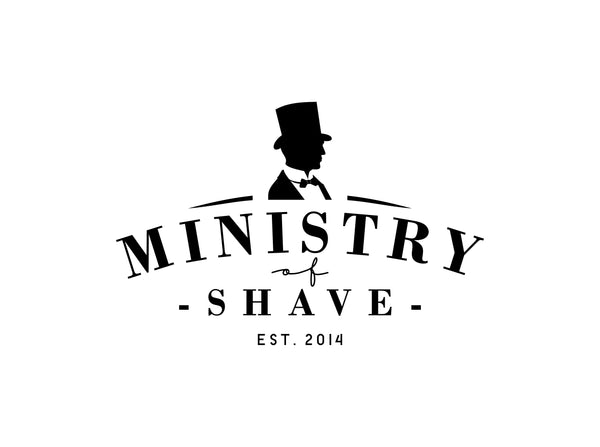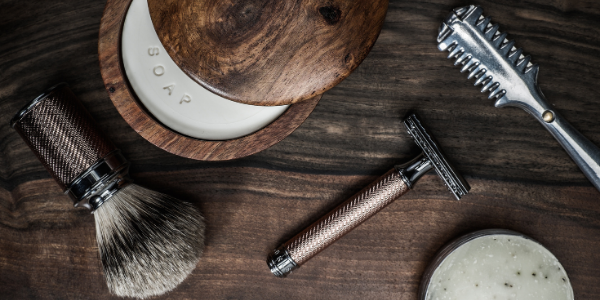Single-Blade Razors vs. Multi-Blade Razors
In many areas of the world, there are people who are perfectly content with any old razor, so long as it shaves off hair. For those people, the idea that there are hundreds of online reviews arguing about which razor is the best is something as noteworthy as a koala in the bush. But there will come a day when they realise just how much they spend on disposable cartridges every month or how much cleaner their shave could be with a better razor.
Instead of leaving you to dredge through the reviews of hundreds of faceless users to find bits and pieces of useful information, we’re here to save the day. Our grooming experts at the Ministry of Shave worked tirelessly—we really put our thinking caps on—and put together the most critical factors to consider if you’re trying to choose between single-blade and multi-blade razors.

Are Multi-Blade Razors Always Better?
Let’s start with a little history shall we!? King Camp Gillette changed the history of shaving when he filed a patent for the first modern-day safety razor in 1901. He did again about 70 years later when he decided to sell a razor with not one but two blades, which doesn't seem like a huge revelation—two is better than one—but it did really change the way people shaved. Yes… Yes it did, the addition of another blade allowed men (and women, we know shaving isn't just for men) worldwide to purchase products that made their morning shaves easier by cutting twice the hairs. As you can imagine, that point was a big feature advertisement wise.
Gillette's idea was so popular that other companies wanted in on the action. A sort of razor arms race ensued (which is not nearly as cool as it sounds), with razors with more and more blades hitting the market to appease growing customer demand. Today some razors have as many as eight edges, and we're sure someone out there is very proud of that.
At least, in theory, multi-blade razors are designed to give a closer shave than traditional razors with one blade. You might expect that’s because you’re cutting two to eight times per stroke, but it’s a bit more complicated than that (well, sort of).

Blade one pulls your facial hair taut, and blade number two finishes the job, cutting the hair below skin level and catching hairs under the surface to give you the closest shave possible. Blades three, four, and so on are backups to clean up any stragglers.
While having more blades does reduce the amount of force shavers need to use while shaving and can cut more hair on the first pass, a single-blade can work just as well with multiple passes. There is one thing you get with multiple blades that you don’t get with one: more blade friction and irritation.
According to dermatologists, men with sensitive skin are particularly at risk for razor bumps, nicks, razor burn, and ingrown hairs—extra blades, extra skin issues.
If you are someone who values a quick shave or has thick enough skin to shrug off some red razor bumps and irritation post-shaves, then feel free to keep shaving with multi-blade razors. Otherwise, your skin will thank you if you make the switch to a single-blade razor. Give it a whirl!
Why Do Multi-Blade Razors Cause Ingrown Hairs?
When the first of many blades pass over your facial hair, it pulls your follicles up and above the surface of your skin to give easier access for the next blade. You will effectively get a very close shave, and a buttery smooth face temporarily but temporarily is the keyword. That close shave comes at the cost of cutting hairs that are usually below the surface of the skin and may even take the top layer of skin right off your face.

As those hairs attempt to grow back, they sometimes don't make it out and remain trapped beneath the skin, becoming, you guessed it: ingrown hairs. Ingrown hairs are especially common for men with curly or wavy hair.
These trapped hairs don't just sit quietly under the skin, waiting for some liberating exfoliation either. They cause red razor bumps, irritation, acne, and just generally make your skin miserable. If they get especially bad, ingrown hair can even lead to painful infections.
How do you prevent all the above and save face? An easy way to prevent ingrown hairs is to shave with a single-blade. Unlike shavers with all those extra blades, these shave at skin level and don’t pull more hair to the surface, allowing your hair to grow back healthily until the next morning shave.
Can a Single-Blade Really Do the Job?
If the reviews of wet-shave experts across the world and men throughout history have anything to say about it, yep. All the glorious beards you've seen on men in sculptures, in portraits, and in those really cool old-timey photographs were the result of a shave by either a straight razor or safety razor.
Razor’s aren't just a plastic thing you see in the bathroom - there’s actual history behind them. Their prevalence can even be found in some records of world civilisations dating back as early as 3000 BC. Men in ancient India and Egypt used copper razors that only vaguely resemble the equipment we use today.
In the 16th century, the bearded elite were able to appreciate a significant upgrade to the Sheffield straight razor. Only barbers were allowed to use it due to its incredibly sharp steel and superior quality.
Later, in the 18th century, Jean-Jacque Perret created the first iteration of the safety razor to make a grooming tool that was safe and useable for men of all skill levels--barber or not.
As a modern man, shaving with a single-blade allows you to shave cleanly through facial hairs with minimal blade friction, a point that reduces the chance of skin irritation and ingrown hairs after each shave. Even without pulling and tugging at your hairs, a single-blade razor can yes, give you the closest and best shave possible.
How Hard Is It to Use a Single-Blade Razor?
We won’t lie. There is a learning curve. It does take practice and patience to learn to use a single-blade reusable razor effectively—but it’s worth it. No bumps and an unbeatably smooth shave shall be your reward for switching over from multi-blade razors once you get the hang of it.
The first thing you need to do is to undergo the proper pre-shave rituals with a shave brush. Forget just running your hand over your face to apply some shaving cream. The single-blade razor experience is luxurious and dignified. It's also practical. Using a brush actually prepares each strand of hair to be easily cut, standing it on end, while your shaving cream holds the hairs in that position to ensure a closer shave.
To begin shaving, just insert the blade into the razor's head. After that, it’s just a matter of practising and learning the proper shaving pressure, speed, and angles that work best with your hair, face shape, and skin sensitivity.

Don’t worry about going all Sweeney Todd on your skin either. Adjustable safety razors make it easy to find a setting that gives you a comfortable and close shave without any nicks. They feature a grill-type design that guards your skin against cuts. Once you safely make it through using the mildest blade angle setting, you can make adjustments until you find the shaving routine that is right for you in terms of comfort and efficiency.
To shave with incredibly sharp straight razor blades takes more effort to master, including learning proper maintenance procedures such as honing and stropping the razor. You have more of a risk of shaving cuts at first because the lack of a guard means that you put the blade directly against your skin, but spending time learning to use a straight razor pays off with baby-smooth skin and easy beard line sculpting. You're going to look fabulous, we promise.
Single-Blade Razors vs. Multi-Blade Razors
If you’ve made it this far, you’ve likely converted and know with all your heart using a single-blade razor is a much better choice than resorting to a multi-blade cartridge razor, but let's recap this story. Single-blade razors such as a safety razor let you get a closer shave without the friction.
Friction from the multiple blades of the average cartridge razor makes skin irritation, razor bumps, and razor burn much more likely.
Single-blade devices also provide the benefit of easier manoeuvrability, especially if you use a double-edge safety razor. Even with a pivot-head or other seemingly high-tech features, using a multi-blade razor at different angles is a challenge.
Safety razors and straight razors, on the other hand, are easy to use at every imaginable angle. As a result, the use of only one razor blade is better suited to sculpting your beard hairs into the perfect shape. The results speak for themselves.
Safety Razor vs. Cartridge
In addition to providing a closer shave with less irritation, a straight or safety razor tends to be more eco-friendly than razors with multiple cartridges. The disposable parts of cartridge razors are designed to be thrown away en masse and are usually made with plastic, contributing to growing environmental plastic pollution.
Over in the US, the EPA estimates that a staggering two billion disposable razors end up in landfills each year. They also predict that there could be more plastic than fish in our oceans by 2050, provided that other environmental disasters have not taken care of us first. Our money is still on a zombie apocalypse.
In direct contrast, single-blade razors are sustainable and built to last with minimal waste. Even when you have to dispose of the blades or the razors themselves, they are usually created with stainless steel and wood. These elements of straight and safety razors are much easier to recycle, letting you comfortably shave without the looming guilt of contributing to the Great Pacific Garbage Patch. Save the planet. Get a straight razor.
Safety Razor vs. Disposable
Of course, in addition to being more environmentally challenged, disposable cartridge razors are usually more expensive in the long run.
Big brands draw you in with inexpensive disposable razors but charge ridiculous prices for replacement cartridges. Companies like Gillette also try to get you to “upgrade” your razor blade every few years. How many times have you suffered through an advertisement for "groundbreaking" features like a pivot-head, battery-powered vibration, or the addition of yet another blade touted to offer better results? These features make almost no difference to your shaving experience.
Single-edge safety razors cost more initially but are much sturdier than their counterparts. The investment in a wooden or metal handle for your razor means having a reliable tool that can last for years.
Instead of changing out the entire head of the razor, you just have to buy more blades, costing you significantly less over time. Safety razors are also less expensive even than straight razors, making them the most cost-effective choice for your shave.
If you are tired of razor bumps, ingrown hairs, and of Gillette having entirely too much of your money, we can help you make the switch to straight or safety razors. Since 2014 our shaving experts at the Ministry of Shave have provided gentlemen with a high-quality shaving experience featuring only the finest razors and natural ingredients. We make our top-of-the-line products directly in Adelaide, Australia, with shipping to customers worldwide.
If you'd like to learn a thing or two more about the world of shaving, keep an eye on our blog and peruse the Ministry of Shave online shop. Stick with us, like you have done with this article. We'll help you find your way to a better facial hair lifestyle.


